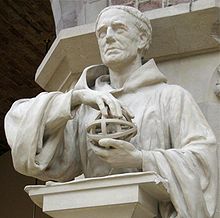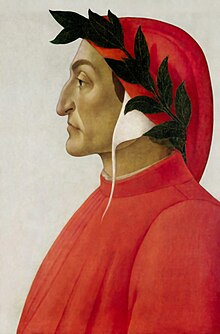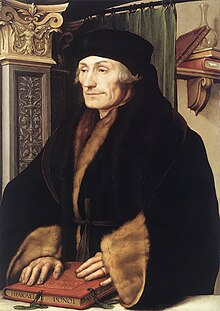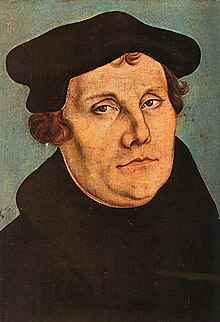Philosophy of the Renaissance and Humanism
The philosophy of the Renaissance and humanism as an epoch (approx. Before 1400 to after 1600) is a section of the history of philosophy that can be viewed as the transition from the philosophy of the Middle Ages, which was entirely under the primacy of theology , to the philosophy of the modern era .
Renaissance means rebirth. The period is so named because the texts of the ancient Greek and Roman philosophers were received anew and at the same time a detachment from the medieval schools of scholasticism took place. The philosophy of the Renaissance and humanism, and with it the studia humanitatis, was still very much connected to medieval traditions in its working method , so it worked speculatively and textually, but it opened up more and more to existing scientific questions and methods that were the dominant theme of the philosophy of the Will form modern times. The educational movement of Renaissance humanism , which was primarily literary, was of particular importance, also with a great influence on the philosophy of this epoch .
Starting points of new thinking
Usually the period of the 15th and 16th centuries is referred to as Renaissance , with the beginning and end of the period extending beyond this. It is a time of economic boom in the cities and the big trading houses ( Hanseatic League , Fugger , Medici ) and the age of discovery . It is the time when the bourgeoisie gained more and more weight and acquired education. Technical innovations such as the development of the compass , the gunpowder , weight wheels watches (1300) and Federzuguhren (ca. 1400), a strong growth in ore mining because of Münzrechte that the rulers because of the Golden Bull of Charles, the IV. Had obtained, and The invention of printing (around 1450) also shows the tremendous spirit of optimism at this time. The increasing weakness of the church in relation to the empire becomes apparent in the papal exile in Avignon (1309–1377), in the great schism (1378–1417) and in the subsequent councils of Constance and Basel .
The roots of Renaissance thinking go back to the 13th century . The universities replaced the monastery and cathedral schools in increasing numbers . Education broadened, and with the Artes Liberales also general philosophical knowledge. Among the philosophers, Scotus (1266–1308) advocated a sharper separation of faith and reason and thus opened the door to the “via moderna” of the nominalism of Occam (1285–1349). Important innovators are, for example, Roger Bacon (1214-1294), according to which science must be strictly separated from theology and must be empirically carried out with experiments and mathematics , Petrus Peregrinus , who was the first to describe the polarity of the compass, Dietrich von Freibergs (approx . 1245–1318) Research into the rainbow or Marsilius of Padua (1275–1343), who in the writing Defensor Pacis (Defender of Peace) advocated a republican society right into the Church and after his condemnation by the Pope joined as well as Ockham Ludwig the Bavarian had to seek refuge in Munich. In a time of ever growing cities in Italy that were becoming more and more independent of the Church , it was above all the poets and artists who used the free spaces and developed their own ways of looking at the world.
Particularly noteworthy among the poets are Dante Alighieri (1265-1321), who was still strongly attached to medieval thought, with his Divine Comedy and his philosophical writing Monarchia , Petrarca (1304-1374), who, as a writer of humanism, was critical of scholasticism and Aristotelianism ( About his and many others ignorance ), and his Florentine friend Boccaccio (1313-1375), who is considered the founder of the Italian novella.
Coluccio Salutati (1331–1406), who was personally acquainted with Petrarch, had an in-depth knowledge of Roman literature and, as chancellor, advocated humanism and civil liberty , was also important for the development in Florence . Among other things, Salutati set up a chair for the Greek language. His student Leonardo Bruni (1369–1444) was also his successor. Bruni became known through translations by Plato, Aristotle and other Greek philosophers and wrote literary texts himself. Later well-known Renaissance writers are Torquato Tasso (1544–1594), François Rabelais (1494–1553), Erasmus of Rotterdam (1466–1536) and Philipp Melanchthon (1497–1560) and last but not least William Shakespeare .
Famous in art include: a. the pioneers were the painter Giotto (1267–1337), who was friends with Dante , the outstanding sculptor Donatello (1386–1466) with his large free-standing bronze statues , the painter Sandro Botticelli (1445–1510), famous for his allegories and paintings of Greek mythologies , and the universal genius Leonardo da Vinci (1452–1519), who achieved excellence not only in art, but also in technology , architecture , anatomy and other areas; furthermore Hans Holbein (1465–1524), Albrecht Dürer (1471–1528), Michelangelo Buonarroti (1475–1564), Tizian (1477–1576) or Raffael (1483–1520). They were all united by the ideal of the union of antiquity and nature , which led them to increasingly naturalistic representations.
Great philosophers

It was also in the republican Florentine environment of the Medici that the solution from Scholastic Aristotelianism came about when Georgios Gemistos Plethon (1355–1450), an enthusiastic follower and translator of Plato , came to Florence from Byzantium during the Council of Ferrara Gained influence. His pupil was Marsilio Ficino (1433–1499), son of Cosimo de Medici's personal physician , who was particularly distinguished by his translations of Plato. Ficino tried to combine Platonic and Neoplatonic thoughts with the Christian teachings and took the view that the similarity of both worlds of thought expressed that there are eternal truths of faith ( natural theology ). According to Ficino, the soul strives to ascend into the spiritual, divine. Will and love as an expression of will serve as decisive driving forces. As a student of Plethon, Bessarion (1403–1472) also moved to Italy and, after converting to the Latin Church and being appointed cardinal, played an important role in the development of Plato and other ancient Greek texts with an extensive library. His concern was the connection of Platonic and Aristotelian thoughts with the Christian faith. Pico della Mirandola (1463–1494) stood up for human dignity , which lies primarily in education. God created the world, but does not work into it, so that man has to open up nature to himself. Pico pleaded for a unification of Greek, Christian and Judaism. His 900 theses, which he put up for disputation in Rome , were forbidden by the Pope and he only escaped the Inquisition through the protection of the Medici, through whom he reached Florence via Paris. Unlike many other Renaissance humanists, Pico considered the content of philosophical teachings to be more important than the aesthetically beautiful form.
Nikolaus von Kues (Cusanus) (1401–1464) played a special role, who, as cardinal and bishop of Brixen , with a special inclination for mathematics and the natural sciences, formulated ideas in the field of epistemology at a very early stage , which only much later was reformulated by Kant were formulated. For him, the mathematization of the objects of experience was the result of the interpretations made by man with his own thinking. Reality is thus created by man and does not exist independently of him. Man is the measure of all things because he transforms all things into conceptual being with his spirit. In the hierarchy of God's creatures, humans come first: “Human nature, however, is that which is exalted above all of God's works and only slightly humbled below the angels, which folds in the spiritual and sensual nature and pulls everything together in itself so that it was intelligently called the microcosm or small world by the ancients. ”( De docta ignorantia III 3) The conception of the spatial-temporal infinity of the universe can also be found in Cusanus. God as the unity of the infinite is reflected in the coincidence of the opposites (finite - infinite) in reason ( coincidentia oppositorum ).
With Lorenzo Valla (1407-1457) there was also a well-known humanist in Italy in the succession of Petrarch , who became famous through the proof, together with Cusanus, that the Donation of Constantine was a fraud. For Valla, who held the office of apostolic scriptor in the Lateran , questions about the freedom of human will and about the highest good were in the foreground. Above all, he endeavored to revive Cicero and also assessed lust positively.
Humanism also had important representatives north of the Alps. Rudolf Agricola (1443–1483), humanist and pedagogue, influenced rhetoric with his work On the Dialectical Method of Thought by demanding that arguments should not only be true but also reasonably comprehensible. Gabriel Biel (1415–1495) was still very close to scholasticism, but developed progressive ideas on economy and at a fair price . Johannes Reuchlin (1455–1522), a student of Angelo Poliziano and influenced by Nikolaus von Kues, was a representative of Renaissance Platonism. He taught at the universities of Ingolstadt and Tübingen and appeared as an opponent of Luther. He came into conflict with the Pope because he opposed the ban on Jewish books. Juan Luis Vives (1492–1540), who saw a progress in Christianity in science, advocated an education based on modern knowledge of nature. The outstanding personality of northern Renaissance humanism was Desiderius Erasmus of Rotterdam (1466–1536), also an opponent of Luther, whom he considered excessive. He was in contact with the Platonic Academy in Florence, was well known to Thomas More and advocated religious tolerance , an outlawing of nationalism and war, and an education based on ancient and Christian foundations. In contrast to him and also to Luther, with whom he was nevertheless closely connected, Philipp Melanchthon (1497–1560) sought to combine the basic ideas of the Reformation with the philosophy of Aristotle in order to create a balance between reason and revelation . In France, Petrus Ramus (1517–1572), who was murdered on St. Bartholomew's Night, stood up for the discovery of new knowledge with a logic different from Aristotle . For the doctor Paracelsus (1493–1541) the predicate mystic is more applicable , but he also has an influence on natural philosophy . The same applies to Jakob Böhme (1575–1624), for whom God appears as life, strength and will and who owes his high profile to his advocacy of individual freedom and the emphasis on free will.
One of the more literary representatives of the Renaissance can be counted the free thinker Michel de Montaigne (1533–1592), who in his essays , which are still interesting in terms of content and linguistically impressive, represented a rather skeptical attitude towards reason and knowledge. He dealt with a wide variety of topics such as literature, philosophy, morality or education. In doing so, he followed the Stoa in disregarding external appearances. He expressed himself critical of scientific superstition, any dogma and human arrogance towards other natural creatures. His student Pierre Charron (1541–1603) is best known for his moral and philosophical work. Francisco Sanches (1550–1623), who came from Portugal and lived in France , represented a pragmatic skepticism at a critical distance from Aristotelianism.
Political philosophy also began to move during the Renaissance. Niccolò Machiavelli (1469–1527), who worked as a political advisor in Florence during the exile of the Medici (1494–1512), is to be regarded as a forerunner with a very independent perspective . He developed a rather skeptical image of people who, for him, are primarily oriented towards their needs and desires and who follow less humanistic ideals. According to his main thesis, the exercise of political rule is not to be judged from the moral, but from the usefulness aspect. He sees three state purposes for the republic : freedom of citizens, size and common good . The politician and humanist Thomas More (1478–1535) developed a completely different approach in his utopian novel “ On the best constitution of the community and on the new island of Utopia ”, an image of the state without private property , education for everyone and freedom of religion . As Lord Chancellor , he supported the Counter-Reformation and was executed by Henry VIII .
John Fortescue (1394–1476), chief judge of the royal court of justice in 1442, took the view that the king's authority should be based on public approval and thus opposed kingship by the grace of God. Jean Bodin (1530–1596) stands for the introduction of the concept of sovereignty in political theory . For him right is based on human nature as given by God. Bodin was not yet familiar with any theory of the state treaty . Only the sovereign (whether the people, an estate or a king, remains open) is entitled to enact laws. This argument is still compatible with unqualified absolutism . Finally, the Scot George Buchanan (1506–1582) represented the principle of popular sovereignty up to and including the right to resist when an absolute ruler violates the interests of the national community. The position of the Calvinist Johannes Althusius (1557–1638), for whom the people were politically and religiously autonomous and the state is based on a federal social contract, is similar . A direct rejection of the unrestricted ruling power by a monarch was made by the Monarchomachs, who were influenced by Calvinism, such as Franciscus Hotomanus , Philippe Duplessis-Mornay or Juan de Mariana . The Spaniard Francisco Suárez (1548–1617), the most important representative of the Salamanca School , is often still attributed to the late scholasticism , but emphasized the freedom of the individual and also represented the idea of natural law and the state treaty. The Dutchman Hugo Grotius (1583–1645) is considered to be the founder of international law . In his work De jure belli ac pacis (“On the Law of War and Peace”), he not only proposed rules for international relations in war and peace, but also in Based on the Spanish teachings, he also developed a theory of natural law, which is put into practice through positive law.
Francis Bacon (1561-1626) was an English philosopher and statesman . He is considered a pioneer of empiricism . The saying "knowledge is power" is ascribed to him. According to Bacon, the goal of science is the mastery of nature in the interest of progress . However, man can only control nature if he knows it. The goal of scientific knowledge, however, is determined by the philosopher, who must also find generally binding methods. In addition to his investigation of the idola , the following two conclusions by Bacon were particularly fruitful: firstly, it is not enough to accept a conclusion obtained by induction. Rather, the researcher must examine the negative instances with particular care; these are the cases that prove an exception to a previously valid rule. Because: in philosophy, a single counterexample is enough to refute the (allegedly already proven) truth of a conclusion (with which he had formulated the principle of falsification ). Second, Bacon believed that human knowledge was cumulative. With this he had freed himself from the view of the scholastics , who believed that everything that man could know was already contained in the Holy Scriptures or the works of Aristotle. As a staunch opponent of subtle discussions that could not provide any new knowledge, he relied on in-depth observation of nature and experiment - in other words , empiricism . Scientifically useful observations had to be repeatable for him. For this very reason, Bacon was also prejudiced against intuition : knowledge gained intuitively or through conclusions by analogy did not belong to his worldview as an empiricist .
reformation
The discussion about its need for reform triggered by the encrustation of the church in scholasticism led to the Reformation despite the reform councils ( Basel , Constance ) under the heading “Back to Scripture”. It was not associated with an independent philosophical movement, but, like humanism, stood for the renewal of thought with an emphasis on the role of the individual. It was no longer the Pope's commandments, but rather individual faith that became the standard. Forerunners were Wycliff (1330-1384), who had questioned the sacraments and turned against the ecclesiastical hierarchy, and Jan Hus (1369-1415), who had been burned as a heretic because of similar views. The final break came with Martin Luther (1483–1546), Ulrich Zwingli (1484–1531) and Johannes Calvin (1509–1564). Johannes Oekolampad worked in Basel and Wolfgang Capito in Strasbourg . Religious rites such as pilgrimages , mortifications, etc. The like were rejected as well as letters of indulgence and purchase of offices . What counted was the word through which man finds God. This was the motive for the powerful translation of the Bible. If anything, Luther stood in the tradition of Augustine and rejected the Aristotle-oriented scholastic philosophy as a pillar of the papal reign. Despite this great distance to philosophy and modern natural science, the Reformation contributed significantly to the spiritual renewal and the decline of power of the church with the result of a secularization of schools and universities. The Peasant Wars (1525) intensified this effect as the victory of the princes further consolidated their position. This tendency could no longer be stopped by the internal cleansing of the church ( Catholic reform ) in advance or in the course of the Counter-Reformation . The individualization of belief promoted in the Reformation made the further secularization of philosophy and the development of deist ideas possible in the early modern period .
Philosophy and science
The Portuguese Alvarus Thomaz followed up on the Oxford calculators of Merton College and dealt primarily with issues of movement and change. The transition to the new era is also clearly shown by the Italian natural philosopher Girolamo Cardano (1501–1576), physician and mathematician , known for the cardan joint he invented and banned from teaching at the age of the Inquisition, Bernardo Telesio (1509–1588), Francesco Patrizi (1529–1597), teacher of Platonic philosophy at the University of Rome, and Tommaso Campanella (1568–1639), who spent 27 years in prison because of his Reformation ideas from the Inquisition . In his utopian state draft, the sun state , a priest-king (Sol) rules together with the three princes Pon (potestas - responsible for the army), Sin (sapientia - science) and Mor (amor - education). All people in this state are equal and have a tightly regulated life. Influenced by Nikolaus von Kues and the pantheistic thinking of his time, Giordano Bruno (1548–1600) taught the infinity of the universe. God is the greatest and the smallest, possibility and reality in one. God is not outside, but in the world. Nature itself is divine and in eternal change, God is the principle of eternal change and for human reason cannot be recognized otherwise than indirectly in nature. Hence the incarnation of God is not possible either. These pantheistic ideas led to arrest by the Inquisition and, after seven years in prison, to execution at the stake .
Nicolaus Copernicus (1473–1543), who made a significant contribution to the establishment of the heliocentric worldview through his observations , is less philosophically oriented than known for his scientific achievements . Galileo Galilei (1564–1642), famous for his experiments with falling and the laws of motion derived from them, laid the foundations for mechanics . He also stood up for the teaching of Copernicus, but had to withdraw in old age due to pressure from the Inquisition. He is credited with the defiant saying: “And it does turn.” His commitment to the application of mathematics in natural research has had a decisive influence on the development of the sciences: “The great book of nature lies open before us. In order to be able to read it better, we need mathematics because it is written in mathematical language ”. This also applies to Johannes Kepler (1571–1630), who confirmed Copernicus with his calculations and promoted the application of mathematics: “The human mind sees through quantitative relationships most clearly; he is actually made to understand them. ”The work of these natural scientists was predominantly at the end of the Renaissance and led over into the modern age, of which one can say that philosophy as well as natural science has finally emancipated itself from theology.
Swimming is another example of new thinking . While it was still regarded as unnatural in the Middle Ages and used as a divine judgment , philosophy professor Everad Digby carried out biomechanical swimming experiments in the water in Cambridge, discussed the specific weight and developed a modern swimming theory, which (in French translation) formed the basis of the swimming training of Napoleon's army submitted. It was the time when rules and laws were developed for many sports.
literature
- Ernesto Grassi , Introduction to Humanistic Philosophy. Primacy of the word. 2nd edition WBG, Darmstadt 1991, ISBN 3-534-08770-4 .
- Hanna-Barbara Gerl : Introduction to the Philosophy of the Renaissance. Primus, Darmstadt 1999, ISBN 3-89678-134-0 .
- Paul Richard Blum : Philosophizing in the Renaissance. Kohlhammer, Stuttgart 2004, ISBN 3-17-017591-2 .
- Paul Richard Blum (ed.): Philosophers of the Renaissance, Darmstadt (Wissenschaftliche Buchgesellschaft / Primus) 1999, ISBN 978-3-89678-134-5 .
- Eckhard Kessler: The philosophy of the Renaissance: the 15th century . Beck, Munich 2008, ISBN 978-3-406-57641-6 .
- Thomas Leinkauf : Outline of the philosophy of humanism and the Renaissance (1350–1600). 2 volumes. Meiner, Hamburg 2017, ISBN 978-3-7873-2792-8
- Stephan Otto : History of Philosophy in Text and Presentation. Vol. 3., Renaissance and early modern times . Reclam, Stuttgart 1984, ISBN 3-15-009913-7 .
- Charles B. Schmitt (Ed.): The Cambridge history of Renaissance philosophy. Reprinted from Cambridge University, Cambridge 2000, ISBN 0-521-39748-0 .
- Charles B. Schmitt: Studies in Renaissance philosophy and science. Variorum Reprints, London 1981. (Collection of articles).
- Frederick Copleston: A history of philosophy. Vol. 3: Late Medieval and Renaissance philosophy. Continuum. London u. a. 2003, ISBN 0-8264-6897-7 .
- Sergius Kodera: Thinking in the Renaissance and Early Modern Times. History of Philosophy in Europe 1450–1600. UTB, Stuttgart 2005 ?, ISBN 3-8252-8302-X .
Individual evidence
- ↑ Eckhard Kessler: The philosophy of the Renaissance: the 15th century, Beck, Munich 2008, 7, as well as Paul Oskar Kristeller : Humanism and Renaissance. Volume 2: Philosophy, Education and Art. Fink, Munich 1980, 31
- ^ Ernst Cassirer : Philosophy of the Enlightenment [1932], Meiner, Hamburg 2002, 145
- ↑ Everad Digby: De arte natandi libti duo. http://www.joh.cam.ac.uk/library/special_collections/early_books/pix/natandi.htm ; Arnd Krüger & John McClelland (eds.): The beginnings of modern sport in the Renaissance. London: Arena 1984; John McClelland: Body and Mind: Sport in Europe from the Roman Empire to the Renaissance (Sport in the Global Society). London: Routledge 2007
- ↑ The most extensive bibliography still with Arnd Krüger & John McClelland: Selected bibliography on physical exercise and sport in the Renaissance, in: A. Krüger & J. McClelland (eds.): The beginnings of modern sports in the Renaissance. London: Arena 1984, pp. 132-180.












